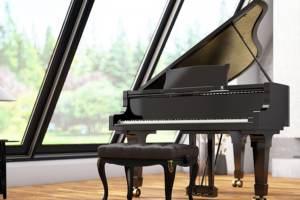Moving a piano within your home might seem simple, but it requires careful planning and some muscle. Here are the keys 🎹 (pun definitely intended) to doing it right to avoid damage to your piano, floors, and walls, or worse, injuring yourself.
Gather a Team

Pianos are heavy and awkward to move. Even a small one can cause injury if you try to move it alone. Call friends or family for help to ensure a safer move for you and your piano.
Beware of the Wheels
Those wheels on your piano? They’re mostly decorative and not meant for long-distance moves. Lift the piano off the ground whenever possible to prevent damage to the instrument and your floors. If you’re weary of that, which you should be, it might be best to consider a piano dolly or leg dollies.
Take It Slow
Rushing the move can lead to mistakes. Give yourself extra time to move the piano carefully. If lifting, take breaks to avoid fatigue. If rolling, go slowly to avoid collisions with walls or scratching floors. There are no heroes in piano moving.
Plan Your Route
Before you start, make sure the new location is spacious enough for the piano. Identify any tight spots, narrow doorways, or steps along the route. Discuss these with your helpers to choose the most efficient path and avoid surprises. Unless it’s an upright piano, you’ll most likely have to stand the piano on its side. Doing this on a skid board or furniture dolly can really help.
Final Thoughts

Moving a piano isn’t like moving other heavy items — it’s a delicate, finely tuned instrument. If you opt to do it yourself, plan carefully, enlist plenty of help, and take your time to ensure the safety of both your piano and your home. Don’t overlook the right tools for the job, either.
When you don’t feel like you have the keys, to bring the pun back, and it seems like too much, trust the professional movers on uShip to do the heavy lifting for you.




